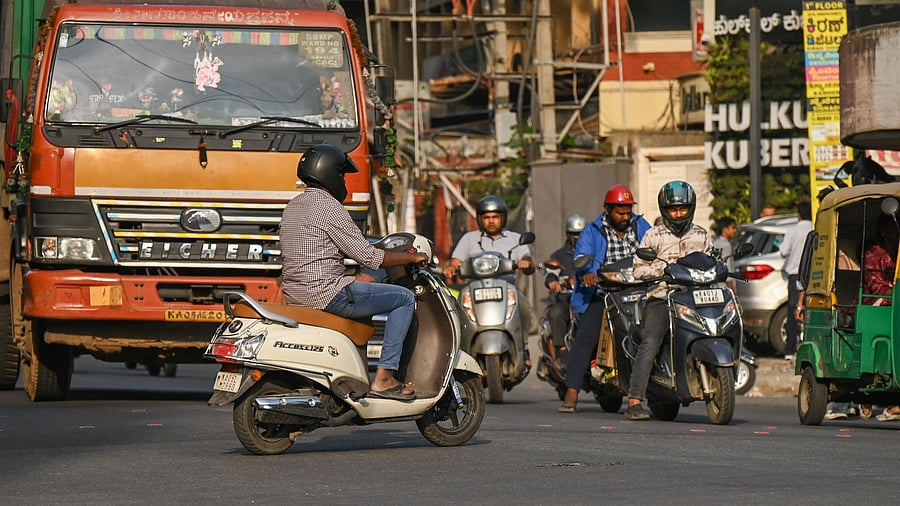
A motorist jumps the signal near Lalbagh West Gate.
Credit: DH Photos/S K Dinesh
Bengaluru: In 2024, Bengaluru’s vehicle users collectively paid over Rs 7.4 crore in fines for seven specific violations, with more than 3.4 lakh traffic offences being caught during special drives conducted by the Bengaluru Traffic Police.
Every year, while adequately dividing time and energy between enforcement, traffic management and regulation, the city’s traffic police focus on cracking down on violations that pose a risk to public safety or peace of mind. In “special drives”, they have targeted seven violations – defective silencers, triple riding, no entry, against one-way, riding on the footpath, demanding an excess fare, and refusing to go for hire. The last two are focused on auto-rickshaws.
These violations require special physical drives by the police because cases cannot be detected nor registered via contactless means, thus requiring human intervention. Over the past three years, these special drives have seen fluctuating results, with 2023 seeing a dip in some categories before the numbers bounced back to astonishing figures next year, similar to 2022.
For example, the traffic police booked 4,38,014 cases for ‘no entry’ violations and 1,62,617 cases of triple-riding in 2022 alone. Last year, over 15,000 cases were registered against two-wheeler users who rode on the footpath and over 1.49 lakh cases of triple riding were detected and penalised. In 2024, police collected Rs 7.43 crore in fines for these seven violations.
Deterrence effect minimal?
Despite such large numbers, the pattern at the outset indicates that while the drives have continued and fines have been paid, the deterrence effect appears to have been minimal.
However, a senior traffic police officer explained, “While we do crack down on these violations, it is incorrect to assume that they do not have any deterrence or that these drives are simply to collect money. Higher numbers indicate stricter enforcement. Such violations, especially triple riding or riding on the footpath are also reflective of lack of awareness about the safety risks, which is what we aim to point out through the drives,” the senior traffic police officer explained.
Experts highlight that most such violations are reflective of poor road user behaviour and lack of education, batting for improved traffic education, public transport, and infrastructure design, besides stricter enforcement.
In former police chief of Bengaluru M N Reddi’s words, effective enforcement needs certainty, severity and immediacy of action against violation to work in tandem. “In Bengaluru, while certainty has improved due to cameras, immediacy remains lacking. Offenders can often go years without being caught or penalised, making the enforcement feel less urgent,” he said, noting that the resolution of cases has not kept pace with the sheer number of violations recorded each year, leading to a lack of deterrence effect.
Imposing more fines or hiking the fine amounts are not the remedy, noted Alok Kumar, ADGP (Training), formerly the ADGP for traffic and road safety in Karnataka. “Whatever provisions are detailed by law need to be strictly implemented. Paying fines might not make much of an impact; confiscating the licence after repeated violations or filing an FIR for dangerous driving is more impactful. There need to be specific drives that find and fine repeat violators, especially those that have committed tens of violations, file FIRs against them, and suspend their licences,” he said.
Traffic and road design aspects
“Are many of these violations still occurring because people are frustrated at having to wait for long on the roads?,” wondered M A Saleem, Director General of Police, Criminal Investigation Department (CID), who formerly served as the Special Commissioner of Police (Traffic), Bengaluru. “If we decongest the road and improve public transport, roads will unclog and movement will become smoother. Many of these violations, especially footpath riding and going against one-way, might reduce,” he said.
Muralidhara, Chief Traffic Warden in Bengaluru, also stressed the need to introduce traffic education and responsible driving habits in the school curriculum.
Dhawal Ashar, Head, Sustainable Cities and Transport, WRI India, an urban mobility think tank, highlighted that another factor in reducing violations is infrastructure design, given that road user behaviour and road design are interlinked.
“Infrastructure must self-regulate traffic, so the Traffic Police can focus on enforcement and penalize the violators. Wrong side driving or footpath riding in any manner must not happen, but at some level this is a symptom of a larger problem of automobile dependency, where, infrastructure permitting, people make these choices to save a few moments in traffic,” he said.
Currently, the burden of managing and regulating traffic falls on the traffic police, and with a limited human resource, enforcement everywhere all the time can be challenging. Dhawal noted that design prototypes could be put in place in areas that see a high number of such violations so that it is made difficult for vehicle users to commit such violations by design. “Such design measures will be self-enforcing” he added.